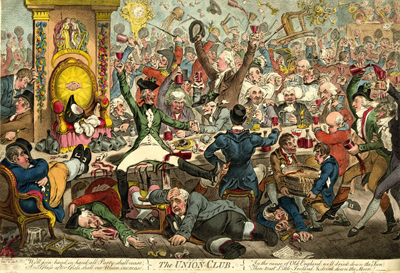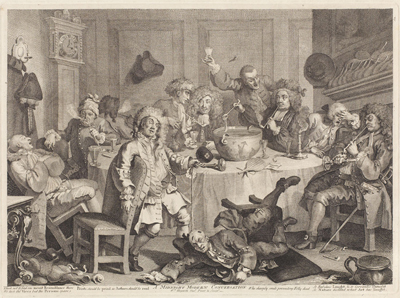The Union Club
By 1801, when he created The Union Club, Gillray had established himself as the leading portrait caricaturist of his time. And he had over the course of 26 years in the business accumulated an extensive repertoire of immediately recognizable caricatures of the most famous men in Britain. Here he brings together more than twenty of them in what is arguably the most brilliant and influential depiction of the effects of inebriation in the history of caricature.

© Trustees of the British Museum
The occasion for the print was the long-awaited implementation of the Acts of Union bringing England and Ireland together as the United Kingdom, and more specifically the opening of the Union Club (on January 19th) that was intended to foster common interests between the countries. Gillray's was one of four prints celebrating the occasion. Two of them were published a couple of weeks after Gillray's: one by Isaac Cruikshank (The Breaking Up of the Union Club (Feb. 8, 1801) and another The Union Club, possibly by Charles Williams, published by S.W. Fores on the same day. Both borrow figures and elements that clearly derive from Gillray's version. A third print, though undated and anonymous, probably preceded Gillray's effort, according to Draper Hill. It includes the same toast to the Union, and portrays eight of the same figures who appear in Gillray's print, but differs from it in style, tone, and even orientation.
![[The Union Club]](../images/bm_union-club2.jpg)
[Untitled] [1801]
© Trustees of the British Museum
But as so often happens when his is NOT the first print out on the subject, Gillray makes sure that his effort, when it appears, is simply the definitive version, crushing the competition by the sheer brilliance of its arrangement, its scrupulous attention to detail, and the manic energy of the performance.
The version by anonymous focuses upon a (presumably) early toast to the union led by the Prince of Wales and supported by the Duke of Norfolk, Erskine, Sheridan?, and Lord Moira on the Prince's side of the table, and by Fox, Derby, and the Duke of Bedford on the other side. Most of the figures are presented in traditional caricature style—in profile. It could almost be considered an illustration of the toast with Sheridan and Bedford shaking hands across the table. The mood is festive and celebratory, but the print is highly structured and ordered with the Prince and the upright throne at the center and with figures on both sides of the table carefully balanced.
Gillray's version is set late in the festivities; it is almost three in the morning according to the clock in the background. In contrast to the order that prevails in the earlier print, Gillray's Union Club is all disorder and mayhem. The throne, with its emblems of accord in the handshake on the back of the throne and the kiss between Britannia and Erin above it, is thrust to one side. The Prince, who leads the toast from his centrally located throne in the earlier print, has vacated the seat of command entirely in Gillray's version, and lies in a drunken stupor beneath the table. His plumed hat with the princely motto, Ich di[en] (I serve) is the only thing left of his "service" to the Union. The table which cuts across the print in the earlier version appears to be angled both horizontally and vertically in Gillray's print, creating an almost drunken sense of perspective. There are no walls or ceiling visible as stable boundaries. As viewers, we seem to be located in the same space as the club mambers. And as we look around, the rest of the company are shown in every variety of inebriation: including quiet enjoyment, gay frivolity, queasy regurgitation, regretful stupor, and angry hostility.
The previous benchmark for the best scene of drunken debauchery was Hogarth's Midnight Modern Conversation (1732). And there is no doubt that Gillray had it in the back of his mind as he created The Union Club.

Midnight Modern Conversation [1732]
© Lewis Walpole Library, Yale University
The overturned chair and sprawling figure in the foreground (the Duke of Norfolk), the dozing figure on the left (Charles James Fox), the upraised arm of the figure near the center of the print (Lord Cholmondeley), the inclusion of quietly smoking and violently retching figures, the clock in the background—all recall Hogarth's print. But though we can sense the influence of Hogarth, Gillray has made every attitude and every figure his own. And there is no doubt that while Hogarth carefully depicts mayhem and disorder, Gillray makes you feel it. Hogarth's drunken figures inhabit a space which remains fundamentally stable. In The Union Club, there are no stable markers, the very air is filled with chaos.
The actual Union Club was opened for the first time on January 19th. Gillray's print lists a publication date of January 21st. Given the complexity of the finished product, there is no way Gillray could have invented, etched, and colored it in two days. So either the print was dated ahead of its actual publication, or (as I would suppose) Gillray planned and mostly executed the print before the 19th leaving only small details to be added reflecting the actual event. The all-important selection and arrangement of figures would have been done in the sketch phase, and their portrayal would have relied on aspects of their characters already well known or portrayed by Gillray in previous prints.
Sources and Reading
- Commentary from the British Museum on Gillray's The Union Club.
- Draper Hill, Mr. Gillray The Caricaturist, 1965, p. 102n
- Draper Hill, Fashionable Contrasts, 1966, #32
- Vic Gatrell, "Gillray and the Union Club," City of Laughter pp. 287-292.
- Thomas Wright and R.H. Evans, Historical and Descriptive Account of the Caricatures of James Gillray #257
- Thomas Wright and Joseph Grego, The Works of James Gillray, the Caricaturist; With the History of His Life and Times pp. 273–274.
Comments & Corrections
NOTE: Comments and/or corrections are always appreciated. To make that easier, I have included a form below that you can use. I promise never to share any of the info provided without your express permission.